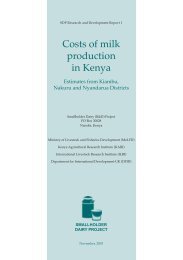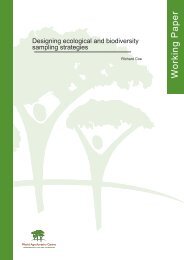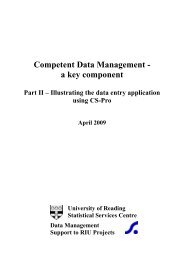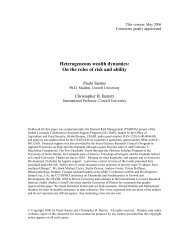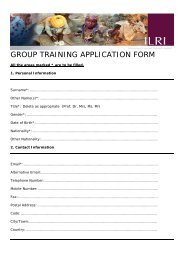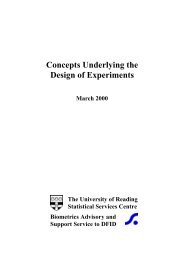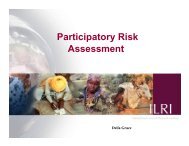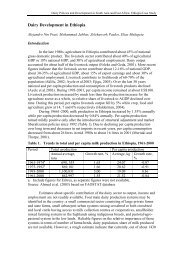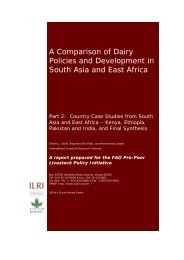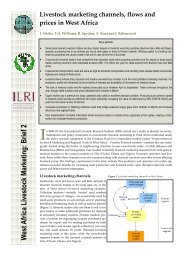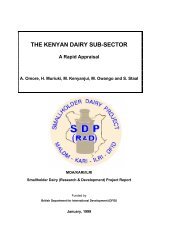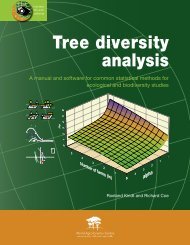Constra<strong>in</strong>ts to productionThe three major constra<strong>in</strong>ts to production are animal diseases, feed resources and nutrition, and the lowgenetic potential <strong>of</strong> native breeds. Diseases are problems for both rum<strong>in</strong>ants and non-rum<strong>in</strong>ants. Theirseverity affects productivity and causes high mortality with consequent loss <strong>of</strong> cash <strong>in</strong>come. Several diseasesare <strong>in</strong>volved and it is not very clear what specific steps have been taken to address these by nationalorganisations with <strong>in</strong>ternational support. Five NGOs are <strong>in</strong>volved actively <strong>in</strong> the tra<strong>in</strong><strong>in</strong>g <strong>of</strong> local governmentagents who undertake vacc<strong>in</strong>ation <strong>in</strong> the villages. Diseases are important only because <strong>of</strong> poor veter<strong>in</strong>ary<strong>in</strong>puts and services. However, it is likely that under-nutrition and management contribute to these problems.Native breeds are perceived to be <strong>of</strong> low productivity by farmers, and genotype is regarded as a constra<strong>in</strong>t toproduction. However, the realisation <strong>of</strong> genetic potential may be simply a matter <strong>of</strong> improv<strong>in</strong>g nutrition,management and disease control rather than the <strong>in</strong>troduction <strong>of</strong> exotic breeds <strong>of</strong> <strong>of</strong>ten dubious value.There are clear opportunities to improve the rum<strong>in</strong>ant feed supply and its utilisation. Urea-treatment <strong>of</strong>straw and the use <strong>of</strong> nutritional blocks <strong>of</strong> urea, rice-bran and molasses are already be<strong>in</strong>g promoted. Grassessuch as Napier grass are be<strong>in</strong>g sown on paddy bunds, and herbaceous legumes such as species <strong>of</strong> stylo couldbe sown on roadsides to be utilised by animals. Multipurpose trees could also be sown on paddy bunds andaround the households, whilst annual legumes could be established as relay crops <strong>in</strong> lowland rice. Significantdevelopments have been made <strong>in</strong> the last decade <strong>in</strong> the selection <strong>of</strong> legumes adapted to acid, <strong>in</strong>fertile soilswhich are more productive than the older Australian cultivars.Ch<strong>in</strong>aNational perspectiveIntroductionCh<strong>in</strong>a has the largest economy <strong>in</strong> the region. Economic growth was 9.5% <strong>in</strong> 1996 and is estimated to be10.5% <strong>in</strong> 1997. Land use is determ<strong>in</strong>ed largely by population pressure, and the need to meet the <strong>in</strong>creas<strong>in</strong>gfood requirements <strong>of</strong> an expand<strong>in</strong>g population with low per capita <strong>in</strong>comes. The country has just started itsN<strong>in</strong>th Development Plan (1996–2000) <strong>in</strong> which food production is a major consideration. Currently, animalprote<strong>in</strong> supplies are <strong>in</strong>adequate to meet requirements and their expansion will be a major thrust <strong>in</strong> the overalleffort to <strong>in</strong>crease food production. Therefore, farm<strong>in</strong>g systems will be orientated <strong>in</strong>creas<strong>in</strong>gly towards moreefficient land use comb<strong>in</strong><strong>in</strong>g ma<strong>in</strong>ly cereals, vegetables and fruits, and, <strong>in</strong> South Ch<strong>in</strong>a (Ha<strong>in</strong>an Prov<strong>in</strong>ce),perennial tree crops such as coconut and rubber. Dur<strong>in</strong>g the last 70 years food gra<strong>in</strong> production has <strong>in</strong>creasedsteadily, and was particularly high from 1978 to 1984. Currently, enough gra<strong>in</strong> is produced for humanconsumption, but surpluses are <strong>in</strong>adequate for use as feeds for the rapidly expand<strong>in</strong>g animal <strong>in</strong>dustries,especially pigs and poultry.The availability <strong>of</strong> agricultural land is decreas<strong>in</strong>g due to the rapid development <strong>of</strong> <strong>in</strong>frastructure andurbanisation. In order to compensate for this decl<strong>in</strong>e, the government is <strong>in</strong>creas<strong>in</strong>g <strong>in</strong>vestment to improvewastelands (about 5.5 million ha) and poor grasslands (31 million ha) and <strong>in</strong>tensify cropp<strong>in</strong>g. Currently, beefand mutton are produced ma<strong>in</strong>ly <strong>in</strong> the pastoral areas <strong>of</strong> the arid and semi-arid northwestern prov<strong>in</strong>ces, butsheep and goat production is also <strong>in</strong>creas<strong>in</strong>g <strong>in</strong> smallholder mixed farm<strong>in</strong>g systems <strong>in</strong> southern regions. Amajor concern is the grow<strong>in</strong>g disparity <strong>in</strong> development between the southeast and the west <strong>of</strong> the country,e.g. average per capita <strong>in</strong>come <strong>in</strong> the former is US$ 220 compared with US$ 110 <strong>in</strong> the latter.Farm size varies across the prov<strong>in</strong>ces based on population density. Farms <strong>of</strong> 0.5–1.0 ha are common.In more developed areas, farm size has <strong>in</strong>creased to 2.0–3.0 ha because farmers are becom<strong>in</strong>g <strong>in</strong>volved withnon-agricultural occupations and are giv<strong>in</strong>g land to others for cultivation. Although rent<strong>in</strong>g <strong>of</strong> land is illegal,a clandest<strong>in</strong>e rental market is emerg<strong>in</strong>g.The Institute <strong>of</strong> <strong>Crop</strong> Breed<strong>in</strong>g and Cultivation <strong>in</strong> the Ch<strong>in</strong>ese Academy <strong>of</strong> Agricultural Sciences(CAAS) has undertaken farm<strong>in</strong>g systems research, ma<strong>in</strong>ly with the f<strong>in</strong>ancial support <strong>of</strong> the IDRC. The workfocused <strong>in</strong>itially on cropp<strong>in</strong>g systems but was expanded to <strong>in</strong>clude crop–animal systems. Strategies <strong>in</strong> farm<strong>in</strong>gsystems research be<strong>in</strong>g considered by CAAS <strong>in</strong>clude:
• Increased cropp<strong>in</strong>g <strong>in</strong>tensities, particularly <strong>in</strong> southern Ch<strong>in</strong>a. It is expected that a 10% <strong>in</strong>crease maybe possible <strong>in</strong> the south <strong>in</strong> general, but up to 25% <strong>in</strong> Hunan Prov<strong>in</strong>ce.• Better <strong>in</strong>tegration <strong>of</strong> crops and animals, and improved forage production and utilisation.• Improved <strong>in</strong>tegration <strong>of</strong> organic and <strong>in</strong>organic fertilisers and the cycl<strong>in</strong>g <strong>of</strong> manure to economise onthe use <strong>of</strong> chemical fertilisers and ma<strong>in</strong>ta<strong>in</strong> an ecological balance.• Increased use <strong>of</strong> biotechnology to enhance yields.• Reduced pesticide use.• Development <strong>of</strong> labour-sav<strong>in</strong>g equipment for plant<strong>in</strong>g and harvest<strong>in</strong>g <strong>in</strong> response to reduced rural laboursupply.The strategies to <strong>in</strong>crease feed supply <strong>in</strong>clude:• Ma<strong>in</strong>tenance <strong>of</strong> rice and wheat output at current levels but maize production <strong>in</strong>creased for food andanimal feed.• Encouragement for farmers to produce more animals as a source <strong>of</strong> cash <strong>in</strong>come, and <strong>in</strong>corporate maize<strong>in</strong> rice-based cropp<strong>in</strong>g patterns for silage.• Wider use <strong>of</strong> green barley and triticale for silage.• Increased emphasis on manure cycl<strong>in</strong>g <strong>in</strong> <strong>in</strong>tegrated systems.Economists conduct farm surveys with biological scientists and assess the demands for technology, theproblems <strong>of</strong> farmers, and the feasibility <strong>of</strong> resolution. Politicians at the prov<strong>in</strong>cial or city council level havealso asked researchers to conduct such studies.The government is impos<strong>in</strong>g less and less control on <strong>in</strong>put and output prices and on the movement <strong>of</strong>goods between regions and markets. One <strong>of</strong> the exceptions is the price <strong>of</strong> milk produced by the Beij<strong>in</strong>g NorthSuburb Dairy Enterprise, which is a collective enterprise deliver<strong>in</strong>g milk to the government-owned process<strong>in</strong>gfactory at a controlled price. The process<strong>in</strong>g factory sells milk through its outlets at a fixed price which<strong>in</strong>cludes a subsidy by the government. The enterprise has been pr<strong>of</strong>itable.The Institute <strong>of</strong> Agricultural Economics <strong>in</strong> the CAAS has undertaken several studies on agriculture andanimal production, e.g. <strong>in</strong>stitutional problems <strong>in</strong> pig production and market<strong>in</strong>g. These have been publishedma<strong>in</strong>ly <strong>in</strong> Ch<strong>in</strong>ese. A major feature <strong>of</strong> these studies is that few concepts related to market economics havebeen used. As the policy framework is shift<strong>in</strong>g from a centrally planned to a market-orientated economy,there is an <strong>in</strong>creas<strong>in</strong>g need to apply the new concepts <strong>of</strong> production and market<strong>in</strong>g to assess technologyoptions, their demands, and impacts at various levels (farm, prov<strong>in</strong>cial and national) <strong>in</strong> the economy.<strong>Animal</strong> resources and production systemsThe feed<strong>in</strong>g <strong>of</strong> animals <strong>in</strong> Ch<strong>in</strong>a is based on the use <strong>of</strong> crop residues and by-products produced on-farm,which are fed primarily to non-rum<strong>in</strong>ants (pigs, chicken and ducks) and, to a lesser extent, to rum<strong>in</strong>ants(buffaloes, cattle, goats and sheep). The order <strong>of</strong> importance <strong>of</strong> species is pigs, poultry, cattle, goats, sheep,buffaloes and ducks. The size <strong>of</strong> these populations <strong>in</strong> 1994 was 83 million cattle, 22 million buffaloes, 394million pigs, 3118 million chicken and ducks, 98 million goats and 110 million sheep. The development <strong>of</strong>animal production systems <strong>in</strong>volves the use <strong>of</strong> these species across a variety <strong>of</strong> AEZs from cool and warmtemperate climates <strong>in</strong> Harb<strong>in</strong> Prov<strong>in</strong>ce <strong>in</strong> the north and Hunan Prov<strong>in</strong>ce <strong>in</strong> southern Ch<strong>in</strong>a, to sub-tropicaland tropical areas <strong>of</strong> Ha<strong>in</strong>an Prov<strong>in</strong>ce <strong>in</strong> South Ch<strong>in</strong>a.Ch<strong>in</strong>a is currently the largest producer <strong>of</strong> meats from all domestic animal species <strong>in</strong> the region and thisis expected to rise further <strong>in</strong> the future. Increased production from animals <strong>in</strong> recent years has been achievedthrough several factors <strong>in</strong>clud<strong>in</strong>g the development <strong>of</strong> an open-market economy, the direct ownership <strong>of</strong>animals by farmers, an <strong>in</strong>creased demand for animal products, an <strong>in</strong>crease <strong>in</strong> capital <strong>in</strong>vestments, and the<strong>in</strong>tensification <strong>of</strong> production systems.Mixed farm<strong>in</strong>g operations are common throughout Ch<strong>in</strong>a and <strong>in</strong>volve both rum<strong>in</strong>ants and nonrum<strong>in</strong>antsat vary<strong>in</strong>g levels <strong>of</strong> <strong>in</strong>tensification. Amongst the animal species, pigs and poultry are especially
- Page 2 and 3:
Affiliation of Authors:Dr C. Devend
- Page 4 and 5:
6.Strategyfor researchJustification
- Page 7 and 8:
AcknowledgementsThe International L
- Page 9 and 10:
esearch opportunities appropriate t
- Page 11 and 12: Table 1.Animal populations and meat
- Page 13 and 14: Introduction2. Characterisation and
- Page 15 and 16: Figure 2. Sub-humid tropics and sub
- Page 17 and 18: Table 3.Human and animal population
- Page 19 and 20: Table 5. Rice-growing environments
- Page 21 and 22: Multiple upland annual crop systems
- Page 23 and 24: Table 6. Continued.Country Importan
- Page 25 and 26: It should be noted that, compared w
- Page 27 and 28: Table 8.CountryCambodiaChinaIndones
- Page 29 and 30: of non-renewable fossil fuels and t
- Page 31 and 32: Overview of researchThere was a sur
- Page 33 and 34: • Identification of alternative c
- Page 35 and 36: Various animal production systems t
- Page 37 and 38: Presently, much of the vegetable pr
- Page 39 and 40: Table 10. Summary of the main socio
- Page 41 and 42: Table 11. Institutions and organisa
- Page 43 and 44: 3. In the ASEAN sub-region, inadequ
- Page 45 and 46: Table 12. Continued.SituationsPract
- Page 47 and 48: 6. Strategy for researchJustificati
- Page 49 and 50: Table 13. Priorities for research a
- Page 51 and 52: VietnamResearch capacity in NARS is
- Page 53 and 54: CRIFC (Central Research Institute f
- Page 55 and 56: IAS. 1995. Proceedings of the Works
- Page 57 and 58: Systems of sub-Saharan Africa. Volu
- Page 59 and 60: or waterlogged in the wet season an
- Page 61: Table A1. Important diseases of ani
- Page 65 and 66: the animal output came from pigs al
- Page 67 and 68: 18-21° North, with an average rain
- Page 69 and 70: In the Nusa Tenggara islands, signi
- Page 71 and 72: Women work 11.5 h/day on average co
- Page 73 and 74: Various Australian forage projects
- Page 75 and 76: village production systems; to stud
- Page 77 and 78: The availability of feed in rubber
- Page 79 and 80: of the Ayeyarwady and Sittang river
- Page 81 and 82: Constraints and opportunitiesInadeq
- Page 83 and 84: gaining in importance, and signific
- Page 85 and 86: Table A3. Characterisation of crop-
- Page 87 and 88: Table A4. Interventions in crop-ani
- Page 89 and 90: Table A4. Continued.Project TitleGo
- Page 91 and 92: otations are practised, and there a
- Page 93 and 94: such as abortion. Vaccination cover
- Page 95 and 96: large areas of forests (3.4 million
- Page 97 and 98: Table A6. Some animal diseases repo
- Page 99 and 100: Appendix IIItineraryThe Philippines
- Page 101 and 102: 26 November 1996 am Visit to small
- Page 103 and 104: Appendix IIIList of persons metPhil
- Page 105 and 106: Mr Chhiv Nan, Acting Director, Depa
- Page 107 and 108: Dr U Maung Ngint, Managing Director
- Page 109: List of acronymsAARDACIARADBAEZAIBP



